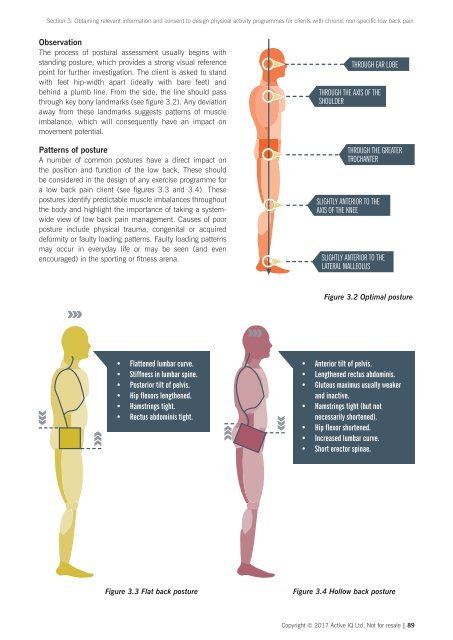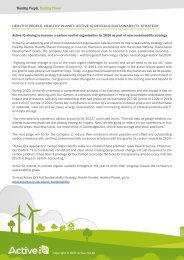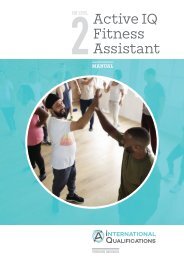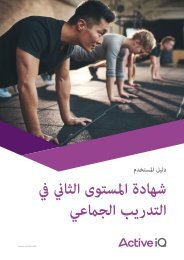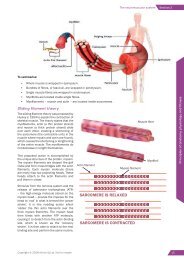Active IQ Level 4 Certificate in Physical Activity and Lifestyle Strategies for Managing Low Back Pain (sample manual)
For more information, please visit http://www.activeiq.co.uk/qualifications/level-4/active-iq-level-4-certificate-in-physical-activity-and-lifestyle-strategies-for-managing-low-back-pain
For more information, please visit http://www.activeiq.co.uk/qualifications/level-4/active-iq-level-4-certificate-in-physical-activity-and-lifestyle-strategies-for-managing-low-back-pain
You also want an ePaper? Increase the reach of your titles
YUMPU automatically turns print PDFs into web optimized ePapers that Google loves.
Section 3: Obta<strong>in</strong><strong>in</strong>g relevant <strong>in</strong><strong>for</strong>mation <strong>and</strong> consent to design physical activity programmes <strong>for</strong> clients with chronic non-specific low back pa<strong>in</strong><br />
Observation<br />
The process of postural assessment usually beg<strong>in</strong>s with<br />
st<strong>and</strong><strong>in</strong>g posture, which provides a strong visual reference<br />
po<strong>in</strong>t <strong>for</strong> further <strong>in</strong>vestigation. The client is asked to st<strong>and</strong><br />
with feet hip-width apart (ideally with bare feet) <strong>and</strong><br />
beh<strong>in</strong>d a plumb l<strong>in</strong>e. From the side, the l<strong>in</strong>e should pass<br />
through key bony l<strong>and</strong>marks (see figure 3.2). Any deviation<br />
away from these l<strong>and</strong>marks suggests patterns of muscle<br />
imbalance, which will consequently have an impact on<br />
movement potential.<br />
Patterns of posture<br />
A number of common postures have a direct impact on<br />
the position <strong>and</strong> function of the low back. These should<br />
be considered <strong>in</strong> the design of any exercise programme <strong>for</strong><br />
a low back pa<strong>in</strong> client (see figures 3.3 <strong>and</strong> 3.4). These<br />
postures identify predictable muscle imbalances throughout<br />
the body <strong>and</strong> highlight the importance of tak<strong>in</strong>g a systemwide<br />
view of low back pa<strong>in</strong> management. Causes of poor<br />
posture <strong>in</strong>clude physical trauma, congenital or acquired<br />
de<strong>for</strong>mity or faulty load<strong>in</strong>g patterns. Faulty load<strong>in</strong>g patterns<br />
may occur <strong>in</strong> everyday life or may be seen (<strong>and</strong> even<br />
encouraged) <strong>in</strong> the sport<strong>in</strong>g or fitness arena.<br />
THROUGH EAR LOBE<br />
THROUGH THE AXIS OF THE<br />
SHOULDER<br />
THROUGH THE GREATER<br />
TROCHANTER<br />
SLIGHTLY ANTERIOR TO THE<br />
AXIS OF THE KNEE<br />
SLIGHTLY ANTERIOR TO THE<br />
LATERAL MALLEOLUS<br />
Figure 3.2 Optimal posture<br />
• Flattened lumbar curve.<br />
• Stiffness <strong>in</strong> lumbar sp<strong>in</strong>e.<br />
• Posterior tilt of pelvis.<br />
• Hip flexors lengthened.<br />
• Hamstr<strong>in</strong>gs tight.<br />
• Rectus abdom<strong>in</strong>is tight.<br />
• Anterior tilt of pelvis.<br />
• Lengthened rectus abdom<strong>in</strong>is.<br />
• Gluteus maximus usually weaker<br />
<strong>and</strong> <strong>in</strong>active.<br />
• Hamstr<strong>in</strong>gs tight (but not<br />
necessarily shortened).<br />
• Hip flexor shortened.<br />
• Increased lumbar curve.<br />
• Short erector sp<strong>in</strong>ae.<br />
Figure 3.3 Flat back posture<br />
Figure 3.4 Hollow back posture<br />
Copyright © 2017 <strong>Active</strong> <strong>IQ</strong> Ltd. Not <strong>for</strong> resale | 89


